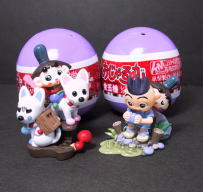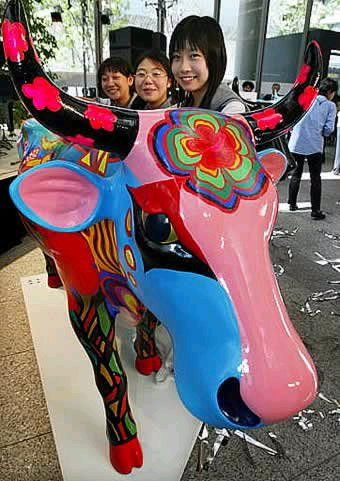

A whirlwind weekend it was that ended, today, with a whirlwind day.

A stay at Ed's is always a pleasant and educational journey into worlds somewhere between Wired and Game Pro magazines (with a healthy dose of Reason). Rain on Sunday only increased the odds of console-gaming competitions indoors.
The Sandman has got me in a wrestling move - the Sleeper, as a matter of fact. I'm going to relent, give dreamland seven or eight hours and write a blog-worthy Albany lowdown tomorrow.

Remember the fifty-cent capsule toys you'd beg your mother for on the way out of the grocery store? Like most of childhood, the irresistable urge to buy every toy in sight miraculously precedes your possession of money. Gooey, green slime and a bright yellow water-growth gargoyle are my most memorable grabs; well-worth the dollar wasted, er, invested between the two.
Nostalgia alone couldn't draw my wallet out for capsule toys - but, as usual, I can't speak for the Japanese. And they've conveniently removed the vending machine middleman:
About two years ago the Japan Toy Association created a new "capsule toy" division and began collecting statistics on the goods. Last year's capsule toy market totaled 26 billion yen a year, according to the association's figures. That was 24 percent higher than during the previous year.A lot of the toys that are being produced are based on themes from the '70s and '80s. Bandai, the biggest producer of capsule toys, brought out its "my elementary school" miniature toys in November last year. Since then, a total of 2.4 million toys from three series have been snapped up by customers. The figures included school backpacks, school lunches with milk, and familiar school notebooks. Many of the customers were reportedly women in their 30s.
Yujin, another major capsule toy maker found success with its "science and learning mini collection." Within two weeks of the release of the series last year 300,000 toys were sold. Although the toys are no bigger than the palm of a person's hand, buyers can actually perform experiments with them. Also well received were capsules containing sets to raise the tiny marine creatures known as Sea-Monkeys. These products drew in male customers in their 20s and 30s.
Of course, chance is what made the capsule purchase fun:
In the past, capsule toy machines were generally used to fill empty space in stores, but since enthusiastic capsule toy fans now often buy whole sets of toys, it is not uncommon to see leisure facilities or supermarkets lining up as many as 100 machines. The Gachapon Kaikan store in Akihabara has 300 dispensers.
We should expect a country with scarce real estate to teach us, once again, that the best goodies don't always come in large packages.

It may have less flair than windshield-wiper glasses, but Japanese sparrows are apparently scared to death of umbrellas - so discovered a farmer who was at the end of his rope searching for the perfect scarecrow. We'll keep an eye out for somebody swooping in to patent it. All that, Edo monuments, spaceman robots and more in this Friday's hat tip to the world's most enjoyably eccentric democracy.
What's a treat from the West without a twist from East? Now, we've all heard rumors about Japanese ice cream. The Mainichi Daily News actually canvassed the product line. Read on - you might develop an appreciation for the ever-ordinary French Vanilla.
And we thought it was only good for July picnic grills and cooking derivatives:
The world's first environment-friendly optical discs made from corn will hit the market from December this year, a Japanese manufacturer has announced.Officials of Sanyo Mavic Media Co., a subsidiary of electronics giant Sanyo Electric Co., said they have found a way to manufacture 10 high quality compact discs from a single corncob.
Named "MildDisc" by Sanyo Mavic, it is equal to conventional plastic optical discs in quality and produces no dioxin or other hazardous material when it is burnt. Moreover, MildDiscs can be degraded into the [soil harmlessly] by micro-organisms.
If this technique is adopted industry-wide, consider the benefits: farmers are given access to another market while the relative abundance of corn knocks record prices down even further than the latest Universal attempt at making nice with consumers. Yes, ladies and gentlemen, The Magic of CornTM could put to rest archaic subsidies and illegal file sharing in one agrarian-space-age stroke!

Urban transportation with style - Japanese style. Who cares if you're stuck in traffic and the meter's running when you've got Hello Kitty accessories to play with? Here's your weekly dose of the country whose culture regularly gives America a run for her money.
ALSO: A taste of Japanese mythology and a tourism leaflet, all in one.

Busy today, so light blogging is in order. (And that's truly light blogging, as opposed to the World's Most Energetic Blogger. This one lifted an eyebrow; Sullivan picked up on it, too. And this morning IP's apparently "making up" for the purported lack of posts. Unstoppable.)
I watched about a third of the Democrat presidential debate last night. No, of course I'm not going to vote for any of them - but I came away with a few observations beyond agreeing with Buckley's assertion that piss-and-vinegar campaigning will lead Bush's challenger to certain electoral doom (Moseley Braun's still peddling the "selected, not elected" line?). More later.
For your diversion: sights and, er, more sights from Japan. The Mainichi Daily News is clever with its teasers drawing in foreigner culture enthusiasts. Parade? Men in ancient garb beating drums? I'm there!

It's for the "CowParade Tokyo," you know? Japanese pop culture and more in this Friday's peek into the land of Sumo and video arcades.
ALSO: I found this fellow's photo diary accidentally. Fascinating.
Remember Gary Larson's The Far Side daily with the angry dog owner scolding his dog Ginger - the dog's translation of which was, of course, "Blah blah blah Ginger, blah blah blah blah Ginger"? Care of our inventive, Pacific brothers, you too can play Han Solo to your dog's Chewbacca:
With the US release of the Bow-Lingual, Japanese Toy manufacturer Takara Corporation tackles what we'd call the little known 'Dr. Dolittle Market' (i.e. the people who want to talk with the animals). The Bow-Lingual aims to translate "dog" into "English" - converting simple dog barks into phrases printed on the unit's small, portable LCD screen. It's ingenious, innovative, and interesting - but somewhat flawed.
Part of that flaw, explains the article, is that dogs aren't exactly enigmatic or worth $100 of United Nations-style translation. Read on.

